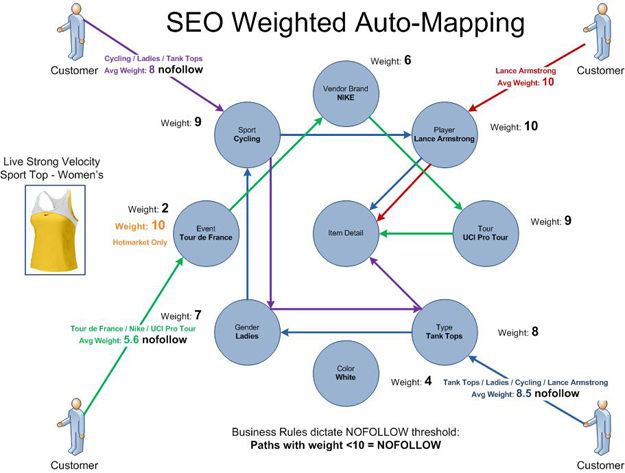This is the fifth installment in a series that blends website architecture, data structures, and Search Engine Optimization (SEO) marketing into a collaborative design pattern continuing from Part 4 - Best Business Practices for Product Catalog Data Structures - SEO Path Aliasing.
We have discussed custom-tailoring a website's NOFOLLOW and Path Aliases to tightly tune the "stream" of natural search flow throughout your website. By tuning what the search engines "see" you will be able to help your search engine rankings climb for the pages that you most care about. In large scale e-Commerce platforms, it becomes an onerous task to keep up with all of these customizations. Here is another case where your choice of an atomic data model will serve to automate some of these functions.
Let's examine the following model of SEO Weighted Auto-Mapping:

Here is a scenario where we assign "weights" to the various Property nodes that can be mapped to Products. Once the weights are assigned, we can develop custom business rules that will help us "scale up" or "scale down" our Weighted Path's sensitivities to the search engines (through the use of NOFOLLOW tags).
We can roll back to the original case of a standard brick and mortar store that was the basis of our e-Business (for example). In a traditional brick and mortar business, let's say that we determined that in general, segmenting our customers by Gender tended to be the most common and most popular means of diverting our customer traffic. This could give us a clue on our e-Commerce website on what weight to assign to the Gender Property. Since this Property holds primacy over the rest of the Properties in our categorization scheme, we could assign it with a high "weight" value.
Take our example above where we have decided that the Player Property is the highest ranking "Path" starting point in our categorization schema. This is essentially because, in the cycling apparel business, Lance Armstrong (the keyword phrase) drives a significant portion of our prime traffic. It also tends to be a highly competitive term that we would like a high search ranking for. Additionally, it is a phrase that we would like to channel a lot of natural search traffic through, even to the exclusion of other lower performing phrases that have a significantly lower revenue opportunity. For this, we assign the Player Property (regardless of the specific Player identified) a weight of 10. This means that a customer that "lands" on the Lance Armstrong Player landing page who directly orders a product is defining the primary Customer Path that we are interested in promoting and that path gains a score of 10 / 1 (hop) which averages out to a 10 (no surprise). Any links to this particular URL do NOT receive the NOFOLLOW parameter and the natural search engines will stream most of their energy through links like this.
We also have the option of defining our business logic for what rules we want to apply. One example is how we set the threshold for NOFOLLOW parameter placements. We have decided in the above example to set NOFOLLOW parameters on any Customer Paths that rank less than an average of 10. Effectively we are deciding that we want the full "stream" of the natural search engines to flow through these highly weighted paths, which will tend to be very direct links through Products mapped to the Player Property.
We can layer in other business rules as well. One business rule that we are using in the above model is the method of computing a multi-step Customer Path "weight". In the example above, we simply decided to add the cumulative weights of all "hops" in each Customer Path and divide by the number of hops. Take the Customer Path of "Tank Tops / Ladies / Cycling / Lance Armstrong". Each "hop" as the customer steps through that path adds to our total and because there are four hops along the path, we divide the total (34) by the hops (4) and come up with an overall weight of 8.5. This business rule may be subject to some review. It seems that an alternative formula might be to reduce each hop's weight by the "distance" from the initial starting point. This would then be 8 + (7-1) + (9-2) + (10-3) = 28 / 4 = 7. However you decide to "compute" the average weight of any given Customer Path, it should make sense for your business while delivering some automation where possible for the NOFOLLOW mappings within your categorization scheme.
This demonstrates yet another possible use of blending the choice of data structure with your requirements for SEO initiatives. We can explore more methods of integrating data models with Search Engine Optimization techniques in Part 6 - Best Business Practices for Product Catalog Data Structures - Search Optimization.